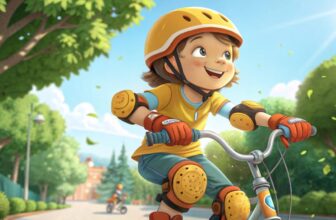Embarking on the adventure of choosing the perfect bike size for your child can feel like navigating a maze. Imagine the joy on their face as they effortlessly pedal away, confidence soaring with every turn.
In this article we unravel the secrets to finding that ideal fit, ensuring safety, comfort, and endless fun on two wheels. Whether you’re a first-time buyer or upgrading to a bigger ride, our comprehensive guide makes sizing up a breeze!
Choosing the Right Size
Finding a bike that fits your child just right is like finding that magical pair of shoes—essential for their safety and a smooth, fun ride. Let’s see what goes into picking the perfect size and why getting it right makes all the difference.
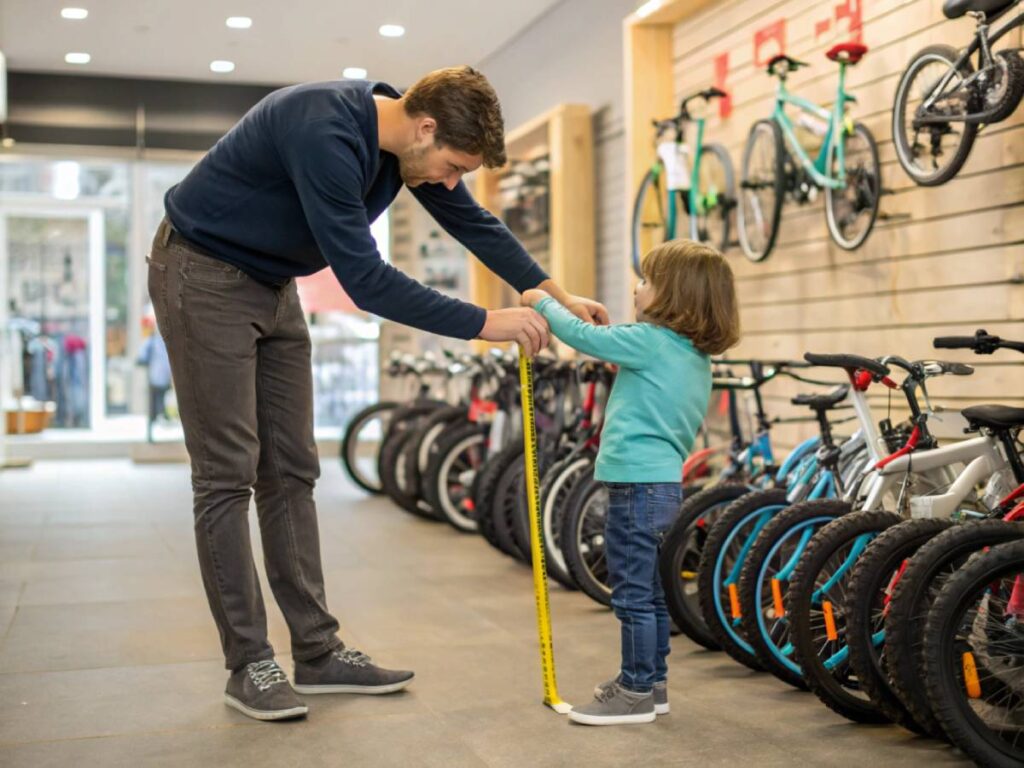
What to Think About
Fitting a bike isn’t one-size-fits-all; it’s all about matching it to your child’s inseam and height.
- Measuring Inseam: This fancy term just means the length from floor to crotch. It’s the secret sauce for choosing a bike that lets your kid have both feet grounded comfortably, boosting their confidence and stopping any sudden crashes. Have them stand with shoes off, feet slightly apart, and measure from the ground to the highest point of the inner thigh.
- Height: While the inseam’s your main man, considering height is like icing on the cake. Height charts give you a rough idea of where to start. Bike companies provide guides linking height ranges to wheel sizes.
| Wheel Size (in) | Inseam (in) | Height (ft) |
|---|---|---|
| 12 | 14-17 | 2’10” – 3’4″ |
| 14 | 16-20 | 3’3″ – 3’7″ |
| 16 | 18-22 | 3’7″ – 4’0″ |
| 20 | 22-25 | 4’0″ – 4’5″ |
| 24 | 24-28 | 4’5″ – 4’9″ |
- Seat Post Peek: A quick peek at the seat post can tell you if things are going south. If the seat’s pushed too far up and exposing the minimum insertion mark, the bike’s a no-go (Liv Cycling).
“A well-fitted bike not only enhances performance but also builds a child’s confidence and love for cycling,” says Emma Johnson, Professional Youth Cycling Coach.
Why Fit Matters
The right fit isn’t just about looking cool—it’s about making the ride as awesome and safe as possible.
- Safety First: A good fit means a safer ride. A too-big bike leads to wobbly rides and crashes, while too tight means it’s a pain to ride and also slippery on control.
- Cozy Ride: A comfy posture keeps those little muscles relaxed. For the right handlebar distance, have them sit, close their eyes, lift their arms up, and drop them forward. Fingertips should just graze the bars.
- Riding with Confidence: Feeling snug and safe means they’re set to become biking maestros. Let them take a whirl before deciding if the bike’s a match.
Combining both inseam and height gives the best shot at nailing the right fit. Check out how to nail those numbers with our guide on measuring your child for a bike and why a sound fit spells safety in kids bike safety.
Kids Bike Sizes
Picking the right bike for your kiddo is super important for their comfort and safety. Let’s break down what size works best for different ages and heights.
12-Inch Wheels
The 12-inch bike is the perfect starting ride for the tiniest cyclists, usually between 2 to 4 years old. These are often kids’ first pedal bikes or balance bikes, which help them get their bearings and figure out this whole bike-riding thing. The International Bicycle Fund claims that kids on 12-inch balance bikes feel like superheroes—substantially boosting their confidence and independence.
| Age | Height | Wheel Size |
|---|---|---|
| 2-4 | 28″-38″ | 12″ |
Some 12-inch bikes have training wheels, while others skip them, letting kids master two-wheel balance without worrying about spinning the pedals just yet.
14-Inch Wheels
Got slightly older or taller munchkins? A 14-inch could be the way to go, usually ideal for those aged 3 to 5 years. These bikes are a solid middle ground, more stable than the 12-inch bikes but still manageable. They’re perfect for kids moving up from a balance bike or getting a grip with training wheels still attached.
| Age | Height | Wheel Size |
|---|---|---|
| 3-5 | 36″-45″ | 14″ |
16-Inch Wheels
For the pros aged 4 to 6, a 16-inch bike becomes the way forward. Whether with or without training wheels, this size is often where youngsters spread their wings and ride alone. Some kids might stick with training wheels while getting the hang of it, and others dive right into boss-level bike riding (16-inch bike).
| Age | Height | Wheel Size |
|---|---|---|
| 4-6 | 41″-49″ | 16″ |
Sixteen-inch bikes sometimes come with hand brakes, adding that next layer of skill—perfect for teaching the tiny speedsters how to stop safely (teach kid bike brakes), boosting their confidence.
Choosing the right size guarantees your child a ride as smooth as butter. For tips on how to measure your little biker for the perfect fit, head over to our guide on how to measure your child for a bike. To keep them safe while they conquer their new wheels, don’t miss our article on kids bike safety.
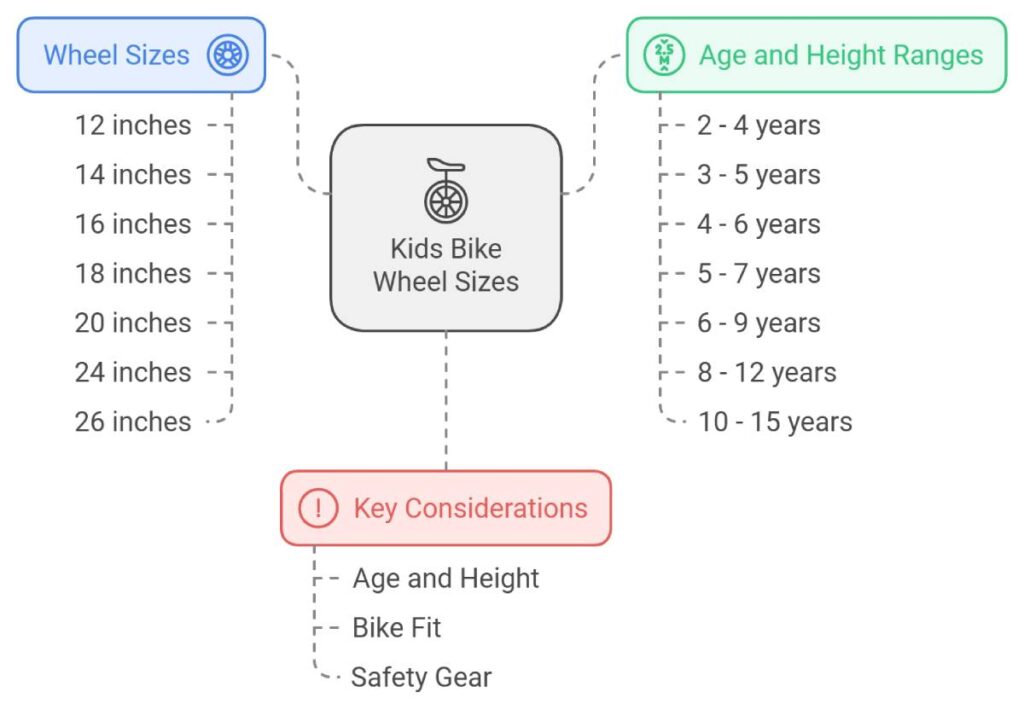
Transition Bikes
Gonna get your kiddo up and rollin’? Transition bikes help your little speedster jump from starter bikes to ones with a bit more oomph. They’re built for growing kids finding their biking mojo. These bikes balance between being kid-friendly and loaded with some cool features to keep up with those squirts leveling up their skills.
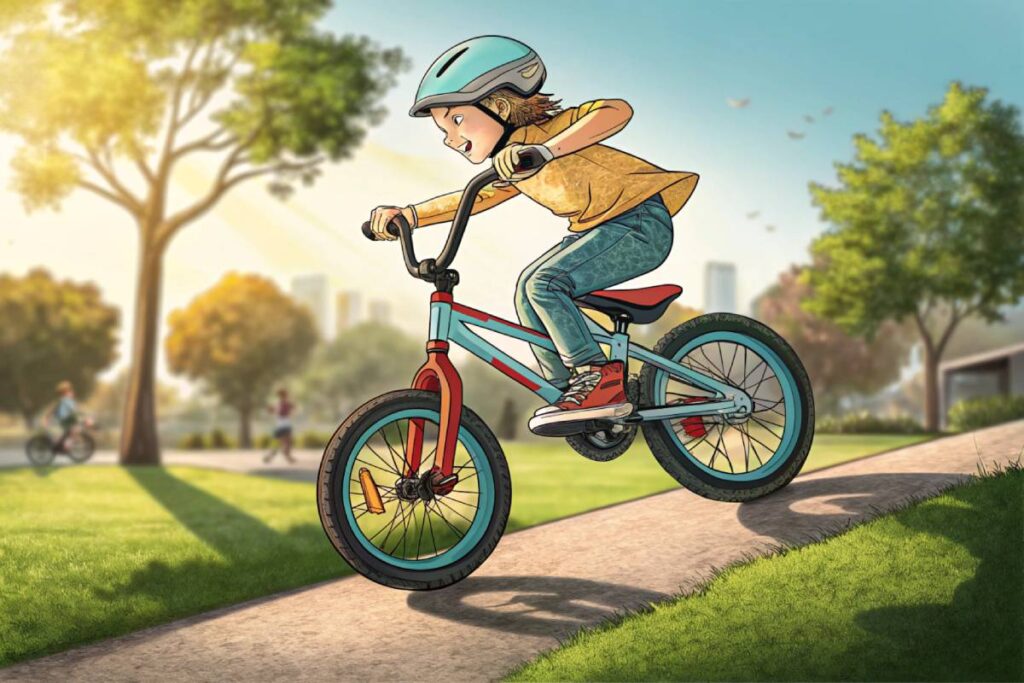
18-Inch Wheels
We’re talkin’ 18-inch bikes here. Perfect for mini-motorists around five to nine years old who stand between 3’6″ and just over 4 feet tall. These rides usually sport snazzy removable training wheels, handy for when your kiddo’s ready to ditch ’em and ride like the big kids.
Quick peek chart:
| Age Range | Height Range | Cool Features |
|---|---|---|
| 5-9 years | 42″ – 52″ | Removable training wheels |
20-Inch Wheels
Got a slightly older whippersnapper? Look out for 20-inch bikes. They’re great for those 6 to 10-year-olds who want to play with hand brakes and experiment with multiple gears. Now that’s what we call an adventurous ride time.
Here’s the scoop:
| Age Range | Height Range | Cool Features |
|---|---|---|
| 6-10 years | Varies | Hand brakes, multiple gears |
Want to demystify bike gears before your tyke hits the pedals? Check our kids bike gears guide.
24-Inch Wheels
24-inch wheels mean serious business—made for tweens who are 8 to 12 years old, standing between 4’8″ and 5’6″. These look like grown-up bikes with gear tricks and suspension, especially in those mountain biking models.
Here’s the lowdown:
| Age Range | Height Range | Cool Features |
|---|---|---|
| 8-12 years | 56″ – 66″ | Gear gizmos, front suspension |
For budding trailblazers, dive into our kids mountain biking guide for more scoop.
When sizing up a transition bike, you’re making sure your budding cyclist feels like a pro. Measure your kid’s inseam and fiddle with the seat height for a fit that’ll have them pedaling with a grin.
Optimal Sizing for Age
Picking the right bike size for your little one not only makes the ride smoother but also builds their confidence and keeps ’em safe. Let’s break down the best bike choices for kiddos aged 2 to 4 and 4 to 6.
Ages 2 to 4
Kids who’ve just learned how to walk can really benefit from balance bikes with 12-inch wheels. These wheelless wonders help them learn to balance without the fear of toppling over (well, mostly!) and build up their confidence. They’re lightweight enough for tiny hands and feet to manage without much fuss and are perfect for little explorers.
| Age Group | Recommended Bike Type | Wheel Size |
|---|---|---|
| 2-4 years | Balance Bike | 12-inch |
Need a bit more info on starting bike adventures? Check out our guide on when to start bike riding, which spills the beans on all things age-appropriate.
Ages 4 to 6
For the slightly older crowd, aged 4 to 6, those small wheeler bikes with 14-inch wheels work like magic. They usually come equipped with coaster brakes for easier stopping. Get that inseam measurement right and tweak the seat height for a fit perfect enough to have them tearing around like little pro riders.
| Age Group | Recommended Bike Type | Wheel Size |
|---|---|---|
| 4-6 years | Small Wheeler Bike | 14-inch |
Curious about the nitty-gritty of choosing the right size? You might find our take on how to measure your child for a bike worth a look.
Besides the bike size, don’t forget about those extras like adjusting handlebar reach and seat posts to match your kid’s dimensions. For the full scoop, click on our pages on kids bike safety and first bike lesson for more tips and tricks.
Refining Size Selection
Picking the right bike size for your kid is like finding the perfect pair of shoes – it’s all about comfort, safety, and having a blast while riding. Let’s zoom in on two smart ways to nail that perfect bike size: figuring out the inseam and tweaking the seat height.
Inseam Measurement
The secret to getting that bike just right largely boils down to the inseam measurement. It’s not rocket science, but it’s a nifty bit of info that makes sure the bike fits like a dream and gives your child space to grow into it. Imagine your kid hopping on their new bike and riding off into the sunset with ease – that’s what we’re going for here.
To get the inseam measurement:
- Have your child stand against a wall with their feet slightly apart.
- Slide a book or flat object between their legs, snug against the groin.
- Measure the distance from the floor to the top of the book or object. You’ve got the inseam!
With that number in hand, here’s a quick guide to match inseam to bike wheel size:
| Inseam Length (inches) | Wheel Size (inches) |
|---|---|
| 14″ – 17″ | 12″ |
| 16″ – 20″ | 16″ |
| 18″ – 22″ | 20″ |
| 22″ – 25″ | 24″ |
To make it an even better fit, adjust the seat height as well.
Seat Height Adjustment
Setting up the seat height is about as important as picking the right bike, especially with how much fun your little adventurer might have. It’s like adding a secret ingredient to a favorite dish – absolutely necessary!
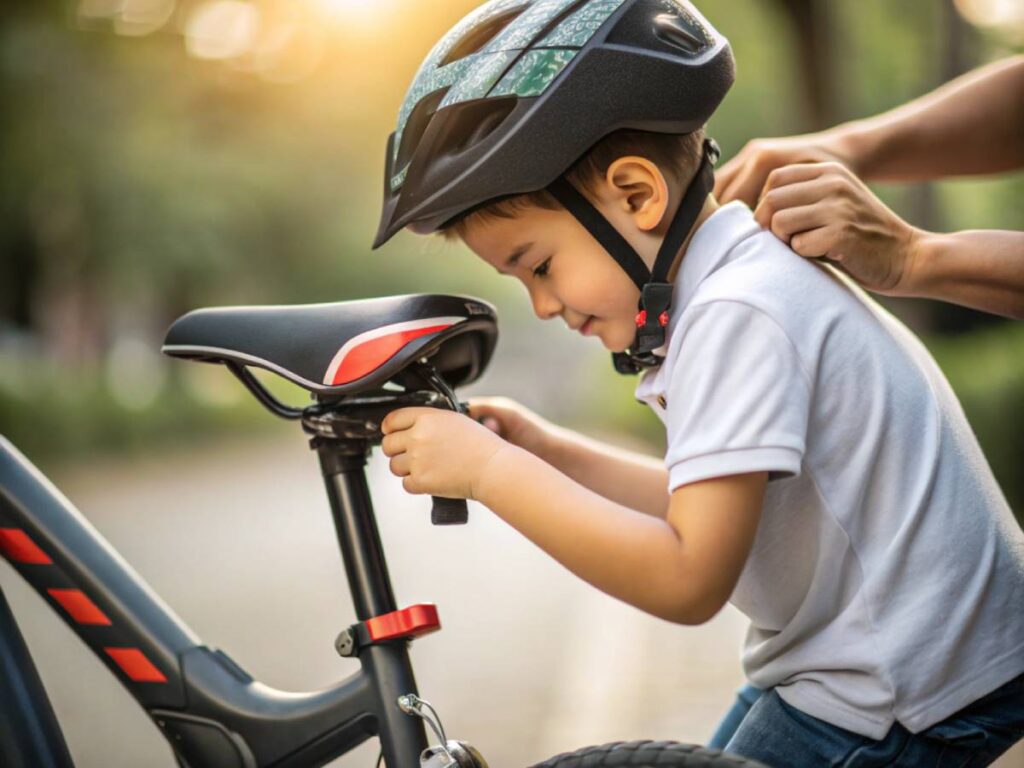
1. For the Newbies:
- Balance Bikes: Set the seat 0.5-1.5″ below the child’s inseam length. This way, they can touch the ground easily and feel secure.
- Training Wheels: Keep the seat at the inseam. They’ll be able to stand on their tiptoes which gives them the confidence to roll.
2. For the Pros:
- Set the seat 2-4″ above their inseam for full leg extension. It’s like achieving their first “grown-up” pedal stroke – smooth and efficient.
Take a look at these seat height tips:
| Riding Experience | Seat Height Position |
|---|---|
| Balance Bike | 0.5-1.5″ below inseam |
| Training Wheels | At inseam height |
| First Pedal Bike | At inseam, then raised as confidence grows |
| Confident Rider | 2-4″ above inseam |
Keep an eye on that seat height as your kiddo grows taller and more fearless. Adjustments here and there can keep their biking experience just right. For more know-how on measuring your child for a bike, we’ve got guides packed with all the info you’ll need.
Keeping your child’s bike well-fitted isn’t just about looking cool—it’s about staying safe and having the best ride ever. A well-sized bike can stop scrapes and spills, and boost confidence by the mile. Dive into our tips on kids bike safety and kids helmet fitting for that extra peace of mind.
Ensuring Comfort and Safety
Handlebar Reach
Getting a child’s bike just right is like finding a pair of shoes that fit perfectly—it matters! The handlebar reach plays a big part in making sure young riders are all set for a smooth, safe ride. Ideally, the handlebars should allow a slight lean forward, just enough to see the path ahead without straining.
Think of it like a superhero pose, elbows slightly bent, giving them both super visibility and control. When this setup is off, it can lead to discomfort or even wobbly rides that bump the danger up a notch.
Here’s the scoop on checking those handlebars:
- Plop the kiddo on the bike in full-ride mode.
- Make sure those handlebars are within comfy reach—no T-Rex arms, no Stretch Armstrong either.
- Look for a gentle elbow bend for natural wrist moves—they help cushion the bumps and give a full steering swath.
Need more scoop on nailing that fit? Peek at our kids bike handlebars guide.
“Comfort is key for young riders. When kids feel good on their bike, they’re more likely to enjoy longer and safer rides,” shares Mark Thompson, Bicycle Industry Specialist.
Seat Post Check
Next up, let’s talk seats. The seat post needs to be adjusted right, like getting the best spot in the living room—comfy but also stable. Check the seat height so it’s just right; the post should stay well below that do-not-cross line. If it’s peeking out, the bike might be a tad too small, adding unnecessary risk (and not the fun, thrill-seeking kind).
Here’s how to make sure the seat post is right on the money:
- Tweak the seat till little feet can touch the ground snugly, without being on tippy-toes or overly grounded.
- Spy that minimum insertion line. No peeking out; it should be snug in the tube.
- Ensure there’s a slight bend in the knees when those pedals hit the lowest dip—this is where top pedaling magic and safety hangout.
Craving more on getting that bike fit just right? Check out our reads on inseam measurement and seat height adjustment.
By setting up the handlebar and seat with care, you can offer the kids rides that are nothing short of breezy and safe, paving the way for joyful biking tales. Hungry for more safety tidbits? Scope out our kids bike safety tips.
Expert Recommendations
Test Riding Tips
Finding the perfect bike for your kiddo isn’t only about snagging the right wheel size. You have to make sure it fits like a glove so your little speedster can zip around comfortably and safely. Here’s how to nail it:
1. Check the Seat Height:
- New riders: Got a newbie in the house? Make sure they can plant their feet flat on the ground while sitting. This helps them hop on and off without any drama and boosts their confidence (Liv Cycling).
- Experienced riders: If your kid’s already a pro, set the seat so they can pedal with ease. A higher seat lets them pedal like a champ.
2. Evaluate Handlebar Reach:
- Don’t squish your kid over the bars or have them stretching like a giraffe. A slight forward lean and a comfy reach make it easy on their wrists and elbows, giving them smooth control and a cozy ride.
3. Ensure an Easy Start and Stop:
- It’s all about that balance. They should touch down easily with both feet when stopping. Take a spin around and practice starting, stopping, and turning to make sure they’re in command.
Craving more scoop on how to perfectly match a bike for your kid? Hover over to our guide on measuring children for bikes.
Growth Spurt Adjustments
Kids shoot up faster than a sunflower, and their bikes need to keep pace. Here’s how you can stay on top of it:
1. Regularly Check and Adjust the Seat Height:
- Keep an eye on how much your kid’s sprouting. Every few months, check the seat height to make sure they’re pedaling along comfortably. For the step-by-step, visit our guide on seat height adjustment.
2. Handlebar Position:
- Arm stretches or scrunches got your kid twisted like a pretzel? Adjust that handlebar so their elbows stay chill with a natural wrist vibe.
3. Transitioning Bike Sizes:
- Biking through the ages? Most kiddos on the cusp of 8 to 9 years fit a 20-inch bike. By then, they might slide onto a 24-inch, but keep tabs on their size. Curious about making the jump? Our guide on when to upgrade kids bikes has got answers.
4. Frequent Test Rides:
- As they grow, time those test rides frequently, especially during growth spurts, to make sure comfort and safety are on point.
- Peek at our article on test riding tips for pro advice.
Staying ahead with these changes will keep the bike ride safe and cushy for your ever-growing champ. Need extra insight to keep the bike fit and safe at its best? Drop by our article on kids’ bike safety.
Keep these pointers in your back pocket, and your kiddo will cruise along smoothly and securely. For even more rad bike tips for kids, journey into our resources on kids cycling benefits.
Conclusion
Selecting the right bike size for your child is more than just a purchase—it’s an investment in their safety, confidence, and joy. From understanding inseam measurements to tweaking seat heights, every detail counts in ensuring a smooth and enjoyable ride.
With our comprehensive guide, you’re equipped to make informed decisions, whether opting for a balanced bike or transitioning to a 24-inch wheel masterpiece.
Remember, the perfect fit not only prevents mishaps but also fosters a lifelong love for cycling. Gear up, choose wisely, and watch your little one pedal into countless happy adventures!
FAQs
How do I measure my child’s inseam for the right bike size?
Have your child stand with shoes off and feet slightly apart. Measure from the floor to the highest point of their inner thigh. Use this inseam measurement to match our wheel size chart for the perfect fit.
At what age should my child transition from a balance bike to a pedal bike?
Typically, children transition to pedal bikes around ages 3 to 5, depending on their confidence and balance skills. Look for signs like steady balance and readiness to pedal independently.
Can my child grow into a slightly larger bike?
While a slightly larger bike can accommodate growth, it’s essential to ensure the current fit is comfortable. A bike that’s too big can hinder control and safety. Regularly reassess your child’s fit as they grow.
What safety gear is essential for kids riding bikes?
Essential safety gear includes a properly fitting helmet, knee and elbow pads, and reflective gear for visibility. These items protect against injuries and enhance safety during rides.
How often should I adjust my child’s bike seat height?
As your child grows, adjust the seat height every few months to ensure they can pedal comfortably and reach the ground easily. Regular adjustments help maintain proper posture and control.

